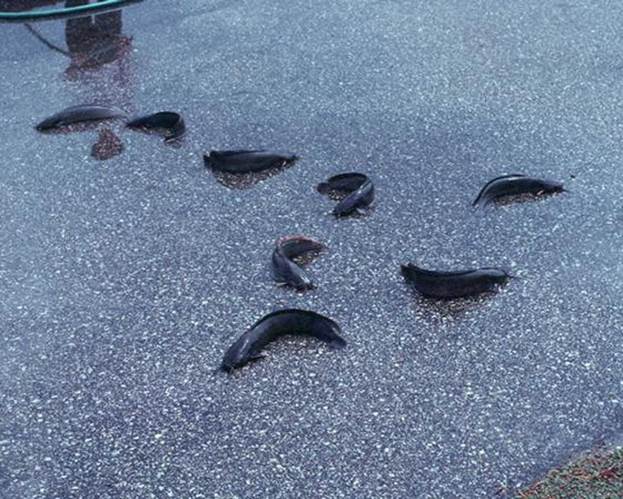
How about pulling into a shopping center parking lot, getting out of your car and seeing a school of fish walking across the pavement?
By Matthew L. Miller
Contributing Writer
You pull into the shopping center parking lot, barely noticing the usual sights. A wayward shopping car. A few pigeons. Someone pushing a stroller. A school of fish. Wait. What?
You look again, and sure enough, there’s a group of fish congregated around a puddle. You note the familiar whiskers of catfish. This shopping center is miles from the nearest river, and yet these fish appear to be alive and well. They might even be snarfing up some worms out of the puddle.
Your day is about to get even weirder. Because those catfish suddenly begin walking across the parking lot. Yes, walking.
They make their way across the parking lot and suddenly dip down into a storm sewer. After a few minutes, you start to question what you saw. Have recent dystopian worries gotten the better of you? Will anyone believe this?
Noah Bressman will. He knows that catfish walking across parking lots isn’t out of the realm of science fiction. It’s happening in Florida. Bressman, currently a postdoctoral research fellow at Chapman University, researches amphibious fish, a fish that can move on land.
His latest publication in the Journal of Fish Biology explores how walking catfish move about and feed on land. This fish, an invasive species in Florida, is even weirder than it appears.
The walking catfish is under increasing threat in its native Asian waters. However, it is thriving outside its native range, particularly in Florida. Likely a combination of aquarium pet releases and aquaculture escapes, the walking catfish is now found widely in the state in canals, wetlands and golf course ponds. It is particularly common in the Everglades region.
The walking catfish, as its name suggests, can move quite well on land. It can cover up to 1.2 kilometers and can survive up to 18 hours out of water. And this tends to freak out some people.
Noah Bressman knows well the reactions that “walking fish” can cause. His fascination began as an undergraduate at Cornell, when he noted a mummichog – a small, East Coast fish species – on the floor of his lab. The fish had leapt out of a tank, probably to escape a predator. But on the floor of the lab, it looked like it had tried to move towards a shiny surface on the floor.
The next day, Bressman saw another mummichog in the same spot. “I hypothesized the fish were making deliberate movements on land,” he said. “They were using vision to find a way back to water. The shiny surface was giving them a cue that it was water.”
This launched his doctoral research at Wake Forest University on amphibious fishes, fish that can survive out of water. One of his research subjects is perhaps the most notorious of “walking fish,” the snakehead. While there are many more devastating invasive fish species, the snakehead grabs media headlines. It has been dubbed the “frankenfish” and spawned a sub-genre of cheesy horror movies.
“People think of fish as completely aquatic animals,” Bressman says. “They don’t pay much attention to a frog on land, even though frogs spend a lot of time in the water. Millions of years ago, fish ventured onto land and evolved. But it is not what we think of fish. When people see fish on land now, they see a monster. Anything that shifts a paradigm, that calls into question how we see the world, is scary. That’s true whether we’re talking about politics or nature.”
Why walking catfish move on land may be easier to answer than how. Like other amphibious fish, walking catfish will “walk” to disperse to new water bodies. They have been observed laying eggs in shallow puddles where young will be safer from predators.
And walking catfish eat terrestrial prey like earthworms and other invertebrates. While they need water to swallow, they can easily feed on invertebrates in puddles and moist spots of ground.
Lab results found that the walking catfish oriented towards natural pond water but moved away from toxic compounds like hydrogen sulfide. The catfish didn’t orient towards distilled water.
While the catfish clearly detected organic compounds that they used to orient, the exact mechanism for this is not known. Bressman says more study is necessary. One possibility is that the catfish use their whiskers, which are essentially covered in taste buds.
A number of observations and videos show catfish out and about in parking lots, often far from water.
One citizen scientist found them in a Payless Shoes parking lot and saw them heading towards a storm drain. “A lot of the observations occur near storm drains,” Bressman said.
The walking catfish have expanded into North Florida. Could they move farther?
“With their ability to move across land and access storm drains, they have the ability to spread quickly,” said Bressman. “Right now, colder temperatures are limiting their spread. But climate change could potentially make other southern states more amenable to walking catfish. Once they get in a system, they’re very difficult to control.”
Despite their invasiveness, Bressman appreciates the fish for what it is. Its ability to move around on land using a sense of smell and/or taste is unrecorded in fish. And there’s much more to understand about this fish out of water.




